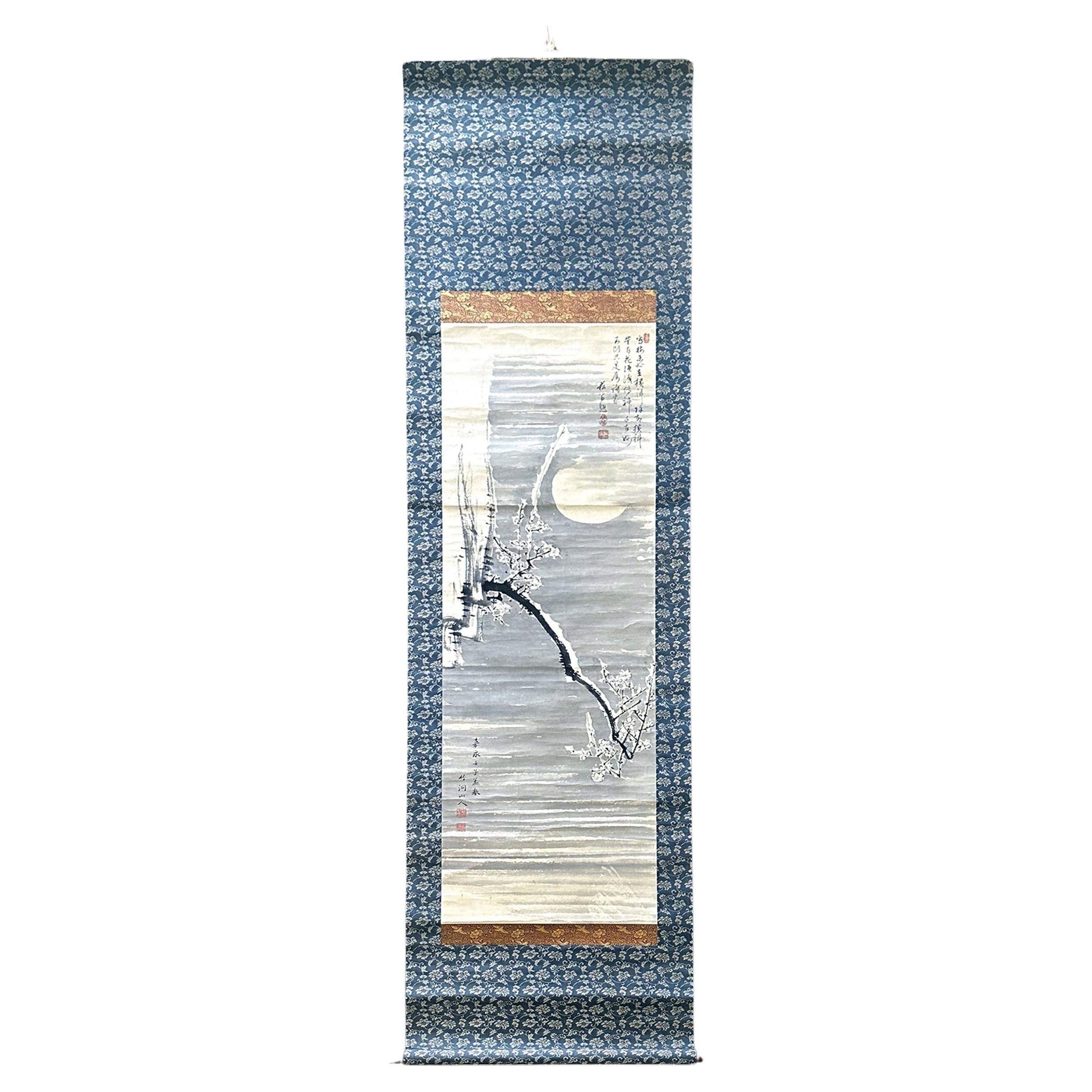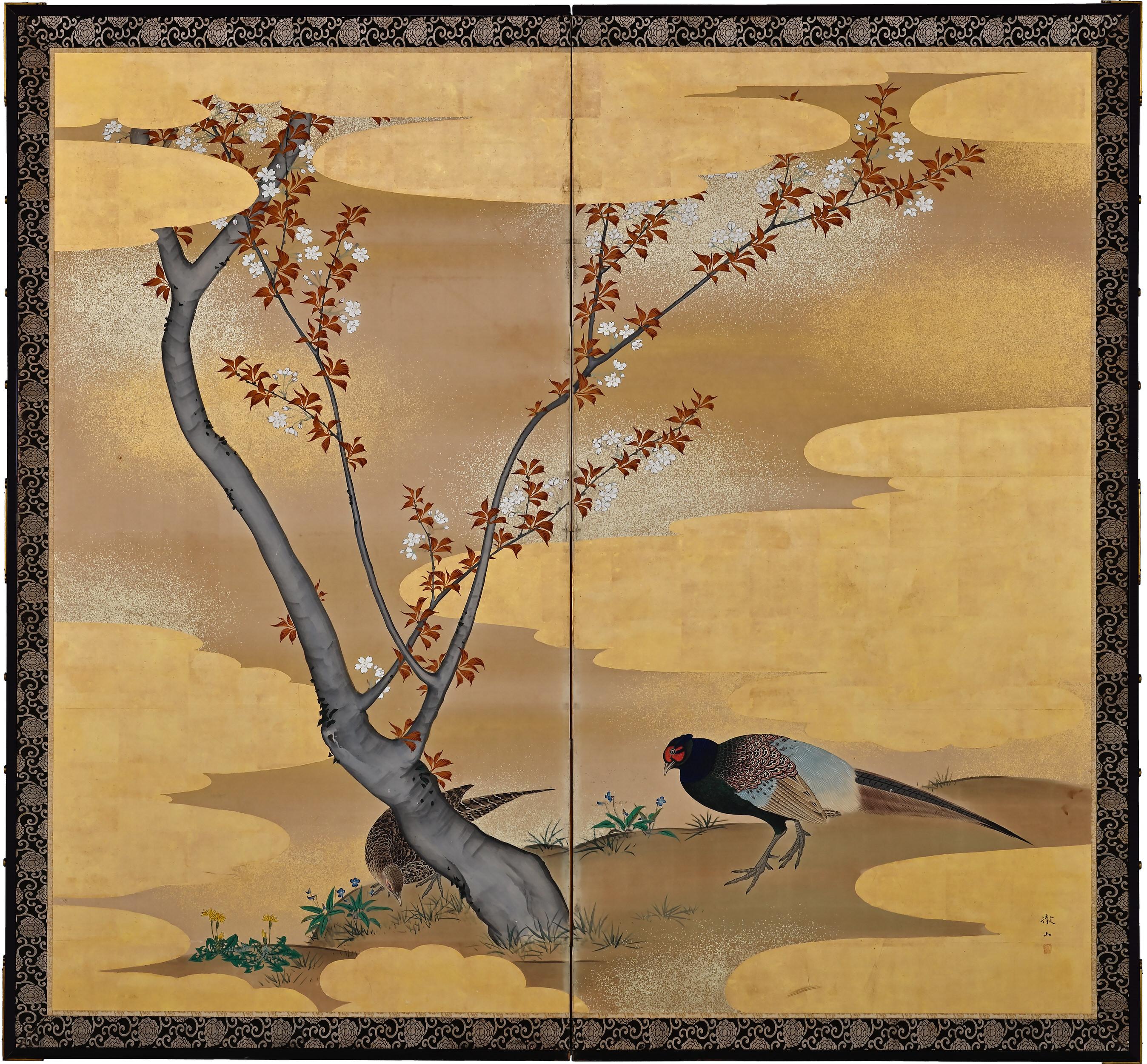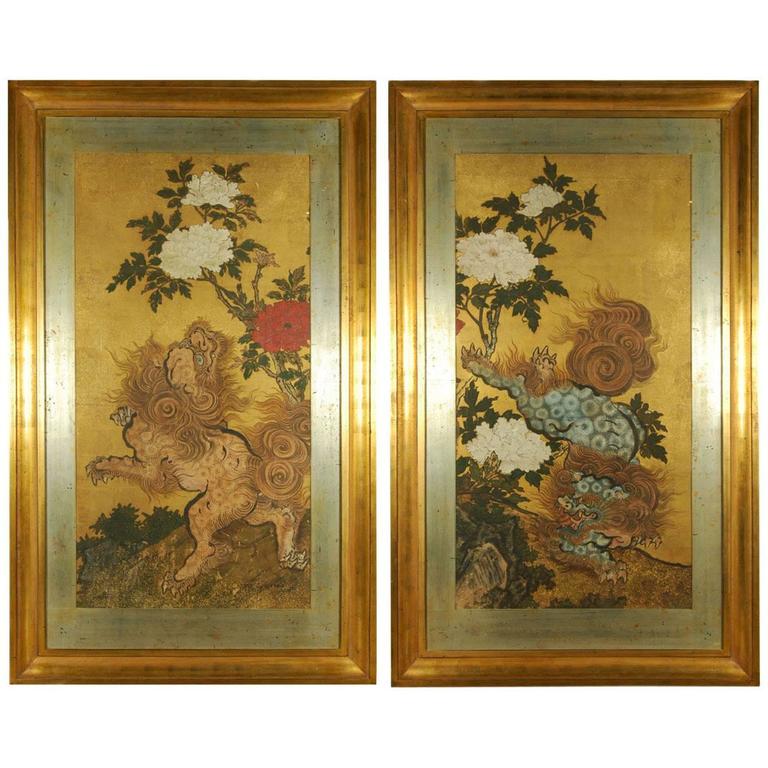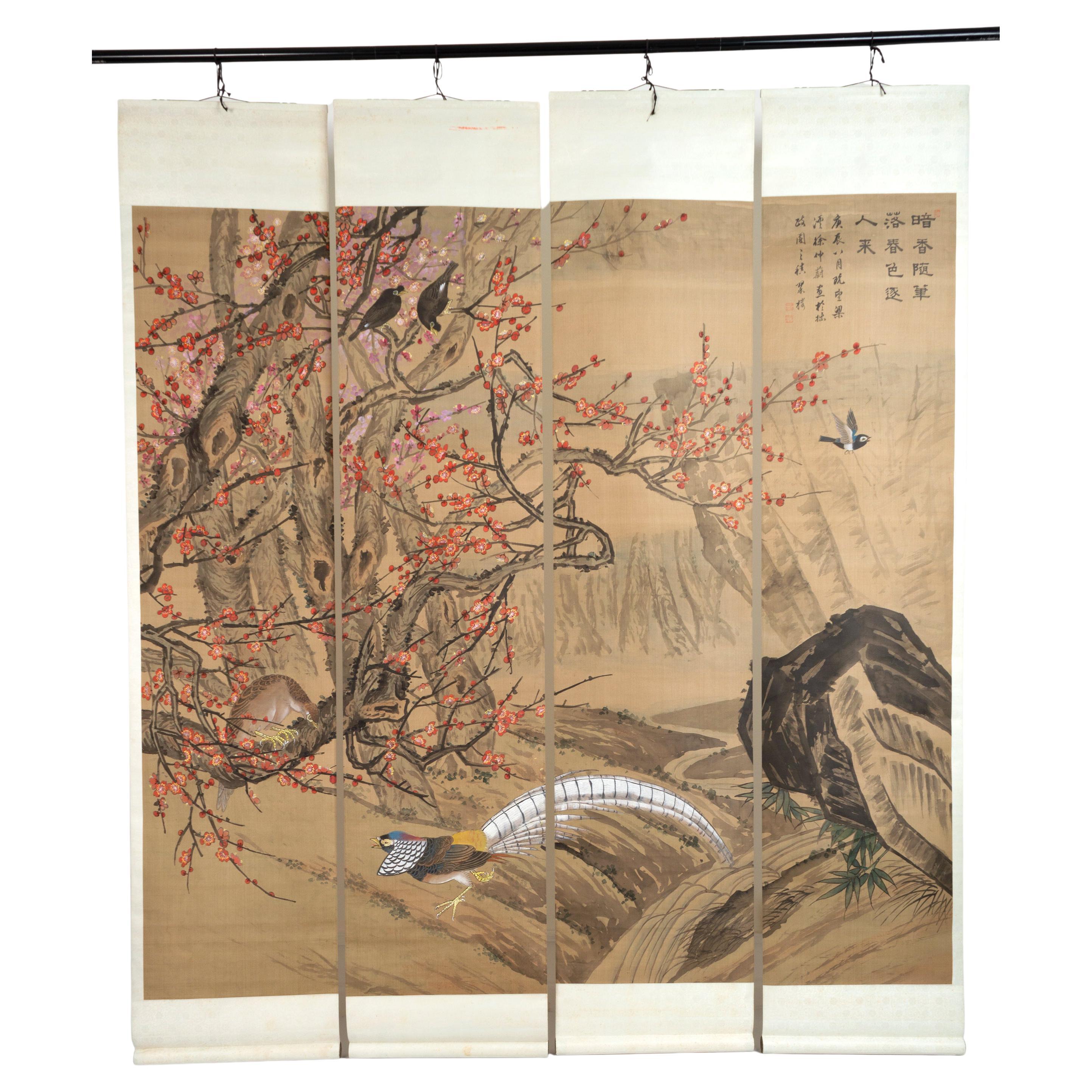Items Similar to Japanese Silk Scroll Painting of Moneys Edo Period Mori Tetsuzan
Want more images or videos?
Request additional images or videos from the seller
1 of 15
Japanese Silk Scroll Painting of Moneys Edo Period Mori Tetsuzan
About the Item
A Japanese mounted vertical hanging scroll painting by Mori Tetsuzan (Japanese, 1775-1841) circa 19th century Edo period. The watercolor and ink on silk painting depicts a family of three moneys perched on a rock in a floral landscape. The style is extremely realistic and quite stunning visually. Artist's signature "Tetsuzan" in black ink and two chop seal signatures "Tetsuzan" and "Shushin" (the other name of the artist) on the lower right. The silk panel was mounted on paper and bordered in patterned brocade. There is detailed script on verso as shown that appears to be the notion from the collector. When fully extended, it measures about 80 inches high.
Mori Tetsuzan was a painter and print artist living in the Edo period. He was by birth the son of Mori Sosen's brother Shuho (1736-1823), but was adopted by Sosen to carry on his artistic line. He first studied with Shuho and Sosen before apparently becoming a pupil of Maruyama Okyo. His work is considered to be in the Maruyama-Shijo School. Several of his scrolls are in the permanent collection of Metropolitan Museum NYC and The British Museum.
- Dimensions:Height: 30 in (76.2 cm)Diameter: 5 in (12.7 cm)
- Style:Japonisme (Of the Period)
- Materials and Techniques:
- Place of Origin:
- Period:
- Date of Manufacture:First Half 19th Century
- Condition:Wear consistent with age and use. Fine antique condition with general light wear commensurate with age. Scattered spots of discoloration, minute stains to background; minor red smear under the red seal as shown.
- Seller Location:Atlanta, GA
- Reference Number:1stDibs: LU945024921262
About the Seller
5.0
Platinum Seller
These expertly vetted sellers are 1stDibs' most experienced sellers and are rated highest by our customers.
Established in 2006
1stDibs seller since 2010
479 sales on 1stDibs
Typical response time: <1 hour
- ShippingRetrieving quote...Ships From: Atlanta, GA
- Return PolicyA return for this item may be initiated within 2 days of delivery.
More From This SellerView All
- Antique Japanese Ink Hanging Scroll Nakabayashi Chikuto Edo PeriodBy Hidaka TetsuoLocated in Atlanta, GAAn ink painting on paper (Sumi-e) mounted with brocade borders as a hanging scroll. Entitled "Plum Blossom Under a Misty Moon", the artist was Japanese painter Nakabayashi Chikuto (1...Category
Antique 19th Century Japanese Japonisme Paintings and Screens
MaterialsBrocade, Wood, Paper
- Japanese Silk Scroll of Daruma Hanabusa Itcho Edo PeriodLocated in Atlanta, GAA Japanese hanging scroll attributed to Edo period painter Hanabusa Itcho (1652-1724). The artwork features a silk roundel nicely mounted in golden brocade background. The painting depicts a robed Daruma seated in meditation with his eyes widely open. The rendition of the famous monk, one of the most beloved subjects in Japanese art, was extremely minimalistic. With just a few effective ink strokes and patches of watercolor, it managed to successfully highlight the essence and spirit of Daruma. The roundel was possibly a center fragment of a larger painting by the artist and was remounted historically. Signed with one of his artist's names. It comes with a wood scroll box with ink inscription of title and artist formal name. For a painting with the same signature, see number 1881,1210,0.1719 in the collection of the British Musuem. Also a horizontal scroll...Category
Antique 18th Century Japanese Edo Paintings and Screens
MaterialsSilk, Paper
- Two Antique Japanese Hanging Scroll PaintingsLocated in Atlanta, GATwo Japanese scroll painting depicts scenes from the Tale of Genji (Genji-E), from Edo period. These painting were purchased from Odewara Shoten in the...Category
Antique Early 19th Century Japanese Japonisme Paintings and Screens
MaterialsBrocade, Paper
- Japanese Silk Scroll by Haruki Nanmei Edo PeriodLocated in Atlanta, GAA Japanese hanging silk scroll by late Edo period painter Haruki Nanmei (1795-1878). The gouache painting was in the tradition of Kano school and depicts an old scholar dressed in lo...Category
Antique 19th Century Japanese Edo Paintings and Screens
MaterialsSilk, Paper
- Japanese Ink and Wash Scroll Painting by Watanabe SeiteiLocated in Atlanta, GAWatanabe Seitei, also known as Watanabe Shotei (1851–1918), was born in late Edo period. He was one of the earliest Japanese artists who visited and be...Category
Antique Early 1900s Japanese Japonisme Paintings and Screens
MaterialsBrocade, Silk, Paper
- Rare Triptych Scroll Paintings by Watanabe Seitei Meiji PeriodLocated in Atlanta, GAA set of three paintings of ink and watercolor on silk mounted within brocade borders as scrolls by Watanabe Seitei (1851-1918). This is a very rare an...Category
Antique Early 1900s Japanese Japonisme Paintings and Screens
MaterialsBrocade, Silk, Wood
You May Also Like
- Antique hanging scroll of Japanese cat/Late Edo-Meiji period/Cat paintingLocated in Sammu-shi, ChibaThis is a picture of a cat drawn by a person named "Toshizumi Nitta" from the end of the Edo period to the beginning of the Meiji period. She is a very simple and cute cat. He is a vassal of the Tokugawa Shogunate, born in Ota City, Gunma Prefecture (southern part of Gunma Prefecture). He was related to the Tokugawa family and lived in a large mansion in the Ota clan in Gunma prefecture. However, the Nitta family's territory was very small, and they were by no means a wealthy vassal. He seems to have lived quite poorly. So he painted cats and sold them to people. The Nitta family continued to draw pictures of this cat for four generations. "Nitta toshizumi" is equivalent to the fourth generation. During the Edo period, sericulture was thriving in the Kanto region. Cats were said to be the gods of silkworms, as they drive away mice, the natural enemies of silkworms. It was the Nitta family who drew such a cat on paper, pasted it in the silkworm chamber, and sold it as a mouse repellent. There were also other monks who painted pictures of cats, but the Nitta family in particular was related to the Tokugawa family, so people believed that paintings of cats had special powers. , a lot of paintings...Category
Antique Late 19th Century Japanese Edo Paintings
MaterialsPaper
- Early 19th Century Japanese Screen. Cherry Blossom & Pheasants by Mori TetsuzanLocated in Kyoto, JPMori Tetsuzan (1775-1841) Pheasants and Cherry Blossoms Two-fold Japanese screen. Ink, color, gofun, gold and silver on paper. A two-fold Japanese bir...Category
Antique Early 19th Century Japanese Edo Paintings and Screens
MaterialsGold Leaf
- Pair of Antique Japanese Paintings of Karashishi, Edo Period, 18th CenturyLocated in Prahran, VictoriaA rare pair of antique Japanese Karashishi paintings in a landscape of rocks and peony flowers on gold leaf ground in fine handmade frames, Edo period, early 18th century. The Karash...Category
Antique Early 18th Century Japanese Edo Paintings and Screens
MaterialsGold Leaf
- Set of Four Japanese Silk Hanging Scrolls Screens C.1920Located in London, GBA stunning set of four Japanese silk mounted vertical hanging scrolls. Dating from C.1920 Taisho Period. The watercolour and ink on silk depicts a larg...Category
Vintage 1920s Japanese Japonisme Paintings and Screens
MaterialsSilk
- Japanese Edo Period Six Panel Screen of Chinese ScholarsLocated in Rio Vista, CAFascinating 19th century Japanese late Edo period six pane funpon screen. Large scale depicting Chinese scholars and officials engaged in leis...Category
Antique 19th Century Japanese Edo Paintings and Screens
MaterialsWood, Paper, Silk
- 1844 - Chichi, Japanese Scroll Painting. Colour on SilkLocated in Kyoto, JPMother’s Breast (Chichi) 1844 Hanging scroll. Ink, pigments and gofun on silk. Inscription: Kouka era, dragon year, late winter, painted by Shozan Yashou Artist’ seals: ...Category
Antique 1840s Japanese Edo Paintings and Screens
MaterialsSilk
Recently Viewed
View AllMore Ways To Browse
Antique Collectors And Period Furniture
Hanging Scrolls
Hanging Scroll
Hanging Screen
Antique Painting On Silk
Signature Scroll
Japanese Paintings On Silk
Painting On Silk Japan
Asian Silk Art Painting
Japanese Screen Black
Silk Painting Japan
Silk Screen Paintings
Japanese Silk Prints
Asian Silk Screens And Paintings
Asian Painting On Silk
Antique Japanese Silk Art
Hanging Art Japanese
Japanese Silk Paintings





